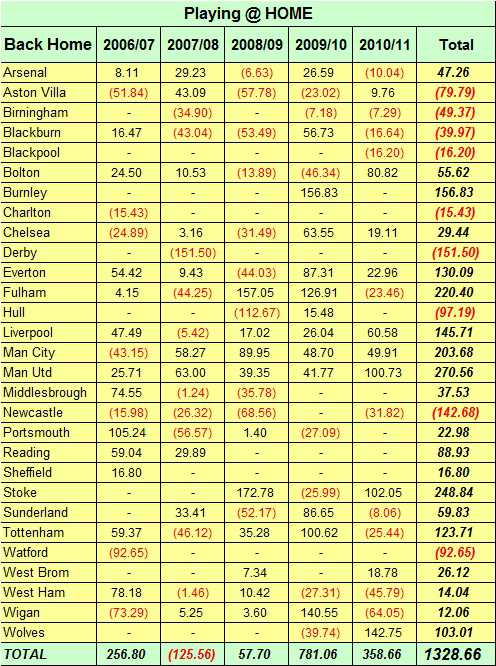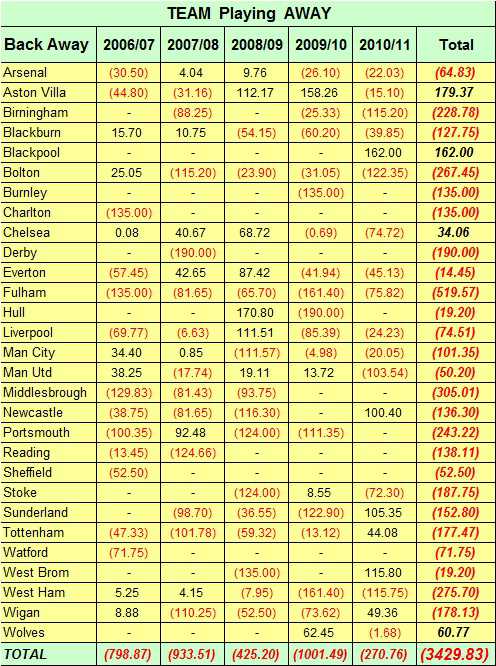
The Numbers Game
Between 2006-2011, if you had gambled unemotionally and systematically on all English Premier League matches to be home wins and placed a constant stake of 10 € per fixture, then at the end of the fifth season, your winnings would have totalled 1,328.66 €.
That’s equivalent to an interest rate of 6.99% on the capital expended (turnover: 1,900 bets @ 10 € each = 19,000 €; 1,328.66 € is 6.99% of 19,000 €), more than double the rate of the best savings account currently on offer in the UK (times have changed since!).
The table below summarises the home record of every team involved in the Premier League during seasons 2006-2011, and shows the end totals from a constant staking plan of 10 units per match:

To reiterate, a bet of 10 units placed on each of the 380 ‘home’ games in a Premier League season, with no omissions, would have resulted in a handsome profit over the five seasons analysed, no matter how the results predicted beforehand (i.e. the odds) were perceived.
It places no reliance upon team news, injuries, form of the teams involved, or any other extraneous factor surrounding the games in question. It’s a quick and easy method to follow just so long as you can guarantee being able to bet on every match for five entire seasons, a total of 1,900 bets (assuming no matches are abandoned and/or replayed).
On the other side of the coin, if you followed the same strategy backing the ‘away’ teams to win every game, then 3,428.83 € would have been lost!

Some illustrations from the two tables: If you chose to refine your strategy and bet only on Tottenham to win every match at home, using a fixed stake of 10 € would have yielded profits of 123.71 € over five years.
However, a strategy of backing Tottenham to win every match away from home would have resulted in a loss of 177.47 €. In the same period, Fulham would have brought a profit of 220.40 € to win every home game, but a loss of 519.57 € backing them away from home.
These tables suggest that it is unwise to bet on any team in the English Premier League to win away from home on a consistent basis.
This is due to a combination of unpredictability in this league where ‘upsets’ happen on a regular basis, and the fact that the odds set by bookmakers and betting exchanges for these games seem not to afford the opportunity of long-term profits (value) for the bettor.
All of the tabular calculations have been based on ‘real’ odds exactly as they were found in the market (Ladbrokes). The losses in the above table indicate that the odds offered for away wins seem to be constantly too short or under-priced considering that on average, only 25% of matches in the English Premier League finish in victories for the away team.
 Image: Symbiot (Shutterstock)
Image: Symbiot (Shutterstock)At this stage we do not have a concrete explanation for this obvious discrepancy in the bookmaker/market odds calculations between home and away prices. The only reason we venture to suggest is that away match prices are perhaps a good mechanism for bookmakers to achieve some form of guaranteed income?
Before beginning this evaluation, our theory was that the results would be relatively balanced between betting on home, draw or away results and that the bettor should theoretically break-even (i.e. the bookmakers wouldn’t allow a significant profit margin to be made from any of these markets).








Hi Probability,
Thanks for your comment. Yes, at the time of writing we used an assumption that odds at Betfair were prima facie around 10% better than traditional bookmakers and guided people towards using betting exchanges to guard against bookmaker account closures for showing signs of success.
With any potentially profitable system, you must always seek out the best odds and oddschecker.com and oddsportal.com are invaluable resources. Only by finding the best possible reward for the hard work you have already put into finding a system will you ever be able to maintain the ‘value’.
We use a combination of bookmakers and exchanges and spread the bets across many markets to stay under the radar but we don’t just monitor the English Premier League and neither do we just back the home team. Yes, the system makes a consistent profit which fluctuates between 4-35% yield on a successful betting round – the trick is definitely to play every round of matches AND to find the best odds for each match, which although time-consuming is ultimately rewarding.
Hi,
This is based on historical data and you have found that it would have been profitable playing home team. But you have also assumed that the odds at betfair is 10% better. Have you verified that it is possible to get 10 % better odds for those matches that you have been analyzed. Many times the odds can be lower at betfair compared to traditionally bookies and your profit will be gone!
My thesis is that if you found a profitable window, by “simple” statistical analysis, this value-bet vill eventually be gone and your system will be losing money! By the time you and your fellows start to increse the turnover for this bet, the market will respond and give lower odds.
Has it been profitable playing whole 2012?
You’r welcome 🙂 I have been looking and reading some of your aricles and i found it to be very interesting and coherent, in particular the value evaluation. Just for fun, i tried to reproduce your results for Backing Man Utd at Home to Win by plaing 10eur. on each of their 19 games and i came up with a profit of 72eur., instead of your 100eur. It’s quite a big difference so i suppose i am doing something wrong with my calculations… could you give any clues to why this is happening?
Thank you.
Hi Helder,
it’s possible that you are using a different staking plan, and/or also different odds.
We used for our calculations Ladbrokes odds which we increased flat by 10% to take the overround out. The staking plan used for the calculations was a fixed risk 10 units, meaning the stakes varied depending on the odds, the loss was fixed.
Hope this answers your question 🙂
Excellent work! I just don’t understand why you only take into account 190 games per season… shouldn’t it be 380 since every game is a home game for someone?
Thank you.
You are right… May I say that this was a test how long it takes until somebody notices? 😉
Thanks, it’s now corrected.
Excellent work! Is there anywhere to see this same system applied to the 2011-12 season?
Please check out the German version of this article. There is a comment which includes an Excel spreadsheet for download from AsaNisiMasa who has followed these predictions in the 2011-12 season and made a 20% profit of his investment.
Hi folks, please pay attention. Soccerwidow’s forecasts here are perfect 🙂 If one would have simply bet on the 4 recommended teams (Fulham, Aston Villa, Man City and Man Utd) without thinking too much last season, one would have landed a 20% ROI! I have to recommend Soccerwidow to all and have donated a small ‘thank you’.
I wish everybody fun reading this blog and/or following the recommendations.
Download Excel spreadsheet.
Thank you, AsaNisiMasa! It’s a pleasure. Here the donate button for guys who wish to do the same:
Here you’ll find some links: https://www.soccerwidow.com/en/miscellaneous/link-listing/?link_robot_category=english&link_robot_subcategory=statistics-and-historical-data
1. Fracsoft is certainly the best, but you’ll have to pay for the data.
2. You can also download from Betfair historical data in Excel format, but I find it a bit messy.
pd: i have clicked mistakenly on delete post on the above post , dont delete my post please!
Hi Soccerwidow, you make the calculation based on ladbrokes odds , data from excel from football data uk , and you put 10% higher (attempt to imitate betfair odds) i know it. You say laying away on premier league its profitable but i have see many odds today , i see many examples that at high odds , betfair odds is greater than ladbrokes odds and difference more than 10%.
lyon toulouse (away odd) 4.33 ladbrokes ; 7 Betfair
chelsea valencia (away odd) 4.33 ;5.4 betfair
apoel shaktar (away odd) ladbrokes 3 ; betfair 3.75
Dortmund Marsella (away odd) Ladbrokes 4.33 ; Betfair 5.7
Oporto zenit away odd ladbrokes4.33 ; betfair 5.7
villarreal napoli (home odd) 4 ladbrokes 5.5 betfair
city – bayern away odd ; Ladbrokes 4.33. betfair 6
…and thats only a small example…
So , my question is , do you know a site with historical data of truly betfair odds? football data uk don’t have betfair odds , it would be useful to attempt make a strategy .
greetings
Before the start of this season (on 24th July 2011) I wrote:
“After having evaluated all 12 tables my result is a follows:
For all who are too lazy to check this prognosis themselves and calculate if it was correct herewith a table for you to download the results.
15 bets with a stake of 10 € (total risk 150 €)
Winnings so far: 55,81 € (37.2% of the total risk)
If one calculates only the 6 losses as ‘investment’, then the ROI (return of investment) is 93%!